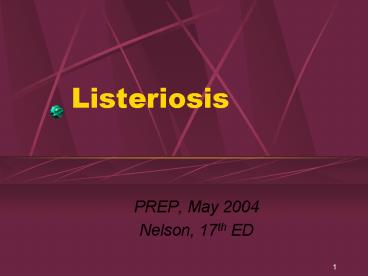Listeriosis - PowerPoint PPT Presentation
1 / 21
Title:
Listeriosis
Description:
... & most disinfecting agents. Microbiology L. monocytogenous is the commonest of the 7 species of the genus Listeria in causing disease. On a semisolid media, ... – PowerPoint PPT presentation
Number of Views:1036
Avg rating:3.0/5.0
Title: Listeriosis
1
Listeriosis
- PREP, May 2004
- Nelson, 17th ED
2
Historical perspective
- L. monocytogenous, why?
- Previously a rare cause of infection but today is
isolated more frequently, why? - Refrigerators.
- Highly processed food.
- Extended shelf life of foodstuffs.
- However it usually doesnt cause disease.
3
Microbiology
- Facultatively anaerobic G , non spore forming
motile bacillus/ coccobacillus/ diplococci,or
diphtheroids like. - It can tolerate low temperatures (4), high pH,
high salt conc. So can replicate in soil, water,
sewage, contaminated refrigerated foods. - Destroyed by pasteurization most disinfecting
agents.
4
Microbiology
- L. monocytogenous is the commonest of the 7
species of the genus Listeria in causing disease. - On a semisolid media, demonstration of a tumbling
motility, umbrella-type formation, hemolysis,
typical cAMP test are sufficient to establish a
presumptive diagnosis of L mono.
5
Epidemiology
- Important cause of zoonoses.
- F- O transmission in animals.
- Usually food- borne.
- Animal to human by direct contact.
- Vertical or horizontal transmission.
- Cross- infection in a neonatal unit through
contact with a contaminated mineral oil used to
bathe infants.
6
Epidemiology
- IP 3 weeks-30 days.
- 5 of healthy adults have Listeria species in
their stool (usuallylt1 mo). - Infectious dose 104- 106 / gram of ingested
product lower in special situations. - 0.7/100,000 general 10/100,000 infants
1.4/100,000 elderly. - Males more.
7
Pathogenesis
- It causes granulomatous reactions micro
abscesses. - Translocations in animals.
- It can cross the intestinal mucosal barrier
once in the blood stream, the bacteria may
disseminate hematogenously to any site but mostly
to the CNS or placenta, liver, spleen.
8
Pathogenesis
- It has the ability to escape from antibodies,
complement, neutrophils. - Intercurrent GI infection with another pathogen,
as shigella sp., may enhance invasion in
individuals infected with L monocytogenous. it
may enhance the transfer of intraluminal m.o
across the intact intestinal mucosa.
9
Immunity
- T cell mediated.
- It is prevented through routine prophylaxis for
Pneumocystis carinii in HIV patients. - Complement, opsonizing antibodies ?
10
Clinical Aspects
- The enteric phase is usually asymptomatic, then
the bacteria crosses the intestinal barrier to be
transmitted inside the macrophages to any organ
but mostly to the spleen liver. - Disease its severity depends on several factors.
11
Intrapartum Disease
- Listeriosis in pregnancy documented mostly in
the 3rd trimester. - Early abortion.
- Second third trimester flu like
- illness or GI, rarely meningitis
with/without - fetal involvement stillbirth,
- premature labour (mortality rate 50-
- 90). It may resolve after delivery even
- without treatment.
12
Neonatal DiseaseEarly Onset
- 1.5 days (lt5 days), mostly through the placenta
(can be ascending). - Strong association with maternal disease.
- Septic like picture predominates, but can be ARD,
Pneumonia, Meningitis, Myocarditis. - Granulomatosis infantisepticum which are widely
disseminated granulomas present in severe
listerial disease (skin, liver, placenta).
13
Late Onset
- Symptoms are several days to weeks after birth,
usually at 14.3 days (5-30) of age. - Transmission is vertical or nosocomial.
- Mostly as meningitis, in a term infant.
- Less common.
- Mothers are culture negative.
14
Nonperinatal Disease
- Most common M.O as a cause of meningitis in
patients with lymphoma, organ transplant
recipients, in those receiving corticosteroids,
in the elderly. - Risk factors include DM., Liver disease, chronic
renal disease, collagen vascular disease, iron
overload, diminished gastric acidity. However
54 of children have no apparent
immunocompromising condition.
15
Nonperinatal Disease
- After the neonatal period 30-55 present with
meningitis. 30 will have neurologic sequelae
(MR, hydrocephalus, e.t.c.) - Rhombencephalitis in healthy adults diagnosed by
MRI. - Bacteremia in immunocompromised.
- Infection in other body organs.
16
Diagnosis
- It should be included in the differential
diagnosis of infection in pregnancy, neonatal
sepsis, meningitis. - CBC.
- Gram stain.
- Culture / 36 hr incubation/ blood, CSF, cervix,
vagina, placenta. - Alert the lab not to discard as a
contaminating diphtheroids.
17
Diagnosis
- CSF. Glucose, Blood Culture, Gram Stain, Protein.
- Rapid detection by MA/ NAH.
- PCR not available commercially.
- Anti-listeriolysin O, a hemolysin mediates lysis
of vacuoles is responsible for the zone of
hemolysis when grown on blood containing solid
media. - Serological test not available.
- Detect contact with animals.
18
Management
- No available controlled trials about the exact
drug or duration of treatment but a minimum of 2
weeks is needed. - Many factors make treatment difficult.
- Antibiotics.
19
Prevention
- Food-borne listeriosis keeping uncooked meat
separate from vegetables. Washing hands, knifes,
cutting boards after exposure to uncooked food.
Regular cleaning disinfection of the insides of
refrigerators. At risk patients should avoid soft
cheeses, reheat ( until steaming hot) leftover
ready to eat foods, avoid cold cuts if unable to
reheat thoroughly.
20
Prevention
- Zero tolerance policy.
- Prophylaxis.
- Vaccine.
- It is a reportable disease.
21
THANK YOU































